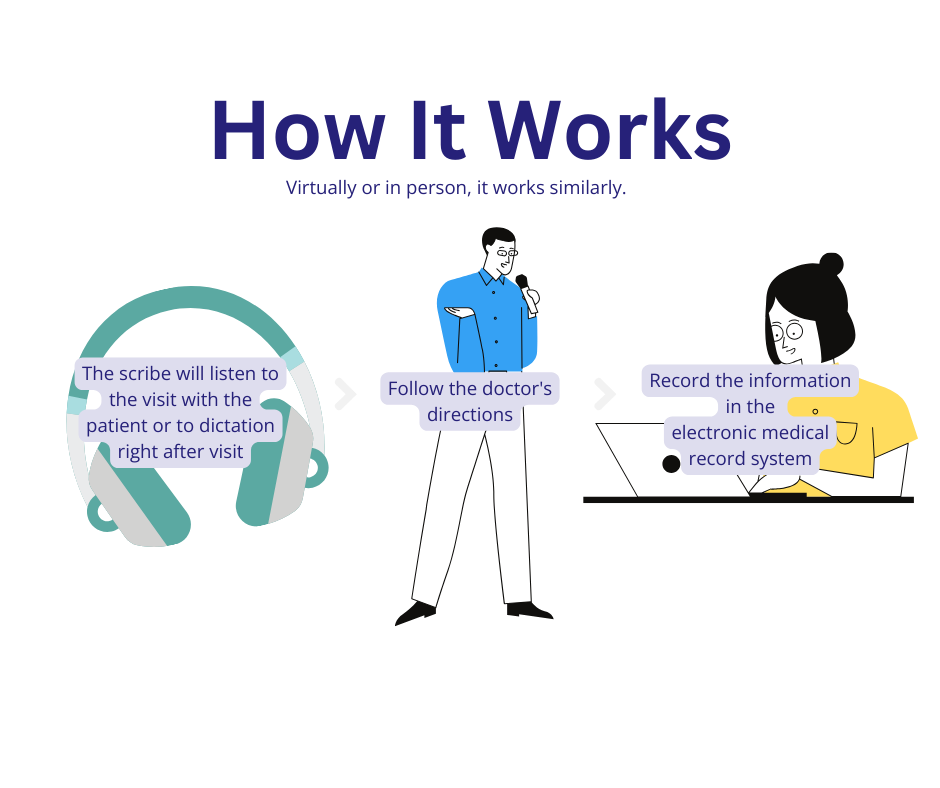The world of medicine is changing quickly, and providers and hospital systems need to keep up with these changes to be competitive in the current environment. As the industry changes, practices must invest in services to help them target some of the most significant pain points. This includes charting and administrative work. Providers must do everything possible to streamline their productivity, allowing them to spend more time with their patients. That is where medical scribes can be helpful. Is a medical scribe worth the investment? There are a few points to keep in mind.
What Do Medical Scribes Do?
Of course, every practice is different, so examining what medical scribes do closely is essential. Medical scribes, also called documentation assistants, take down all the information shared during a patient visit.
They will listen to the visit, follow the doctor’s directions, and record the information in the electronic medical record system. While doctors have documented their notes for a long time, this process has become tedious, impacting the time spent with their patients. A medical scribe can take this stress off their shoulders by placing all the information in the EHR system for them.

Simple workflow for a normal medical scribe interaction with a clinician or physician. Design: DataMatrix Medical 2023
How Do Medical Scribes Help?
There are a lot of specialties out there, so the benefits that medical scribes bring to practices will vary from specialty to specialty; however, there are many expected benefits across all areas, with some of the most prominent examples include:
Medical Scribes Pay For Themselves
When examining whether medical scribes are worth the cost, it is critical to start with the numbers.
In simple terms, hiring a virtual scribe is much cheaper than hiring an in-house one. According to ZipRecruiter, the cost of a medical scribe can be as high as $20.20/hr in 2024. For example, if a physician works a 40-hour work week and needs a scribe during those hours, the cost is $20.20 per hour, which could be as high as $3,232 per month.
Virtual medical scribes (BTW We are not including AI scribes in this comparison because, as software, it is priced differently, and we only want to compare scribes that are 95% and up accurate.) who are properly trained and HIPAA compliant can range from $16 to $19/hr in 2024.
If we used the same 40-hour week as an example, the virtual medical scribe would be 20% less. As you can see, hiring a virtual scribe is much cheaper than hiring in-house. When reviewing services, be sure to ask if they can also accommodate fewer hours. If you are curious about DataMatrix’s pricing, please feel free to reach out, and we will be happy to send you more information or set up a discovery call to see if we can help.
Medical Scribes Avoid Physician Burnout
Physician burnout has become an increasingly prevalent issue in the healthcare industry. Many doctors feel overwhelmed by mounting administrative tasks and electronic medical record (EMR) documentation requirements. This burden often leads to decreased job satisfaction, emotional exhaustion, and a diminished capacity to provide high-quality patient care. Employing medical scribes can be an effective solution to alleviate this problem.
Medical scribes accompany physicians during patient encounters, transcribe the conversation, document clinical findings, and enter relevant information into the EMR system. By offloading these documentation responsibilities, scribes enable physicians to focus on the patient, fostering more meaningful interactions and enhancing the overall quality of care. This improved physician-patient connection can reignite the passion that initially drew doctors to the medical profession, increasing their job satisfaction and mitigating burnout.
Furthermore, the presence of scribes streamlines the clinical workflow, reducing the time physicians spend on administrative tasks after patient visits. This increased efficiency allows doctors to see more patients without a decreased quality of care or extending their workday. By optimizing their time and minimizing the strain of documentation, physicians can maintain a better work-life balance, which is crucial for preventing burnout and promoting longevity in their careers.
Overall, implementing medical scribes alleviates physicians’ documentation burden and addresses the root causes of burnout by restoring the joy and fulfillment of practicing medicine. As a result, physicians can experience increased job satisfaction, improved patient relationships, and a more sustainable work environment, ultimately benefiting healthcare professionals and patients.
Medical Scribes Improve Patient Satisfaction
Providing an exceptional patient experience is vital in healthcare, as it fosters trust, encourages open communication, and promotes better health outcomes. Integrating medical scribes into clinical workflows can significantly enhance patient satisfaction by enabling physicians to establish stronger connections with their patients during appointments.
When physicians have the support of medical scribes, they can devote their full attention to the patient, maintaining direct eye contact and actively listening without the distractions of electronic documentation. This undivided focus facilitates a more personal and attentive interaction, making patients feel valued and heard. Patients often express frustration when their doctors seem more engaged with the computer than with them, which can undermine the physician-patient relationship.
By alleviating the documentation burden, scribes allow physicians to engage in more meaningful conversations, encouraging patients to share their concerns freely. This open exchange nurtures a deeper understanding between the patient and the physician, fostering a trust and rapport that is important for effective healthcare delivery.
With the assistance of scribes, physicians can spend more time exploring the patient’s unique circumstances, understanding their preferences, and tailoring treatment plans accordingly. This approach can improve patient satisfaction and increase adherence to prescribed treatments, as patients feel more invested in their care when their needs and perspectives are genuinely considered.
Scribes’ increased efficiency enables physicians to allocate more time to each patient visit, reducing the feeling of being rushed or neglected. This heightened level of attention and care can enhance the overall experience, leading to improved satisfaction rates and stronger patient loyalty to the healthcare practice.
Medical scribes are crucial in facilitating patient-centered care by empowering physicians to prioritize meaningful interactions, actively engage with patients, and deliver a personalized, attentive experience that fosters satisfaction and positive health outcomes.
Medical Scribe Activities in a Small Practice vs Hospitals
We have worked with medical scribes in both single-physician practices and hospitals, and we can confidently say that the activities that medical scribes do differ quite significantly in these two settings. One key difference is the amount of patient interaction. In a single-physician practice like an orthopedic practice, an orthopedic medical scribe often has more one-on-one time with patients if the scribe is in the office, taking down notes on their medical history and current symptoms.
In contrast, medical scribes spend more time documenting the patient’s progress throughout their stay in a hospital setting via the administration and nurses. Another difference is the level of collaboration with other healthcare professionals. Medical scribes frequently communicate with their physician in a single-physician practice to ensure correct documentation. At the same time, they may work with several different physicians and other healthcare workers in a hospital setting. Finally, medical scribes in hospitals may also coordinate care between different specialties, which is less common in a single physician practice. Medical scribes play a vital role in both settings, but their activities can vary greatly depending on the needs of the practice or hospital they are working in.
In-Summary
Medical scribes are an invaluable asset to the healthcare industry. They provide cost-effective solutions that benefit physicians and patients. Scribes promote high-quality, patient-centered care and a sustainable healthcare system by alleviating documentation burdens and fostering meaningful patient-provider connections. So, if you are considering a medical scribe. What are you waiting for?

Nathaniel Smathers is a contributor to the DataMatrix Medical blog and has a background in healthcare content creation for over a decade. Nathaniel is passionate about exploring the intersections of healthcare, data analysis, and digital innovation.






